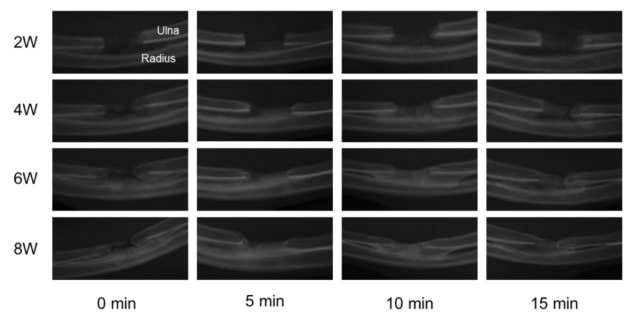Non-thermal atmospheric plasma enhances bone fracture healing
21 Dec 2021 Abayomi Opadele
Bone fracture or loss, caused by trauma, surgery or disease, is a serious medical problem. After bone damage, the healing process depends largely on the severity of the fracture. Several approaches have been developed to accelerate bone repair, including both physical and biological methods. However, existing techniques come with limitations, such as the inability to fully restore the bone’s functionality with minimal scar formation. Bones can be re-combined, but achieving bone regeneration remains a complex task.
Scientists at Osaka City University (OCU) have therefore explored the properties of non-thermal atmospheric pressure plasma (NTAPP) to induce direct bone regeneration within damaged bones. Plasma, the fourth state of matter in which gas becomes ionized, is composed of electrons, ions, high-energy photons and neutral particles. Most artificial plasmas are generated using electrical energy.
Following on from its use in industrial applications, plasma is now also utilized in medicine and bioengineering, accelerated by the development of NTAPP sources. While typical plasmas have estimated temperatures of around 10,000 K, NTAPP can be generated at room temperature and atmospheric pressure. This can create unusual situations in which strongly reactive species exist near biological targets such as cells, tissue and bone. It is thought that low levels of these plasma-generated reactive species can stimulate cell proliferation, although above a threshold dose, they can cause cell death.
Principle investigator Jun-Seok Oh previously developed a helium microplasma jet that minimizes thermal damage to the biological target and maximizes generation of reactive species. Co-principal investigator Hiromitsu Toyoda suggested investigating the use of this plasma for bone regeneration in an animal model.
In their latest study, published in PLOS One, researchers at OCU’s Graduate School of Medicine and Graduate School of Engineering describe the configuration and assembly of this microplasma jet system. The device generates reactive oxygen and nitrogen species, including positive and negative ionic species in the glowing plasma jet, and excited neutrals in an invisible downstream gas flow, into which the biological tissue is placed.
Single plasma treatment heals critical bone defect
Plasma has been used previously as a direct treatment for wound healing or to indirectly generate reactive oxygen species by provoking stem cell proliferation. However, orthopaedic surgeons have faced challenges deploying plasma as a single approach for treating bone fractures. As such, Toyoda and Oh consider NTAPP to be a new therapeutic method.
In this investigation, the team examined 10 female rabbits with an average weight of 3.5 kg. Following sedation and creation of a 10 mm critical bone defect in the animals’ ulnar shaft, the rabbits received a single session of plasma irradiation for 5, 10 or 15 minutes. X-ray images acquired at two-week intervals for eight weeks showed that the plasma-treated bone defects were healed. Repairing injured bones: X-ray images showing bone defect healing two to eight weeks after various plasma irradiation times. Eight weeks after treatment, the images show bone continuity, suggesting bone regeneration and fracture healing. (Courtesy: CC BY 4.0/PLoS One 10.1371/journal.pone.0255861)
Repairing injured bones: X-ray images showing bone defect healing two to eight weeks after various plasma irradiation times. Eight weeks after treatment, the images show bone continuity, suggesting bone regeneration and fracture healing. (Courtesy: CC BY 4.0/PLoS One 10.1371/journal.pone.0255861)
 Repairing injured bones: X-ray images showing bone defect healing two to eight weeks after various plasma irradiation times. Eight weeks after treatment, the images show bone continuity, suggesting bone regeneration and fracture healing. (Courtesy: CC BY 4.0/PLoS One 10.1371/journal.pone.0255861)
Repairing injured bones: X-ray images showing bone defect healing two to eight weeks after various plasma irradiation times. Eight weeks after treatment, the images show bone continuity, suggesting bone regeneration and fracture healing. (Courtesy: CC BY 4.0/PLoS One 10.1371/journal.pone.0255861)Eight weeks after the plasma treatment, the researchers surgically removed and further analysed the animals’ ulnar bones to assess the potential of NTAPP for bone regeneration. Micro-CT images revealed that a single session of plasma treatment stimulated bone fusion in the injured bones without the need for an artificial bone support system. In another histological evaluation, the researchers discovered that ingrowth of new bone in the plasma-irradiated animals was improved compared with a non-irradiated control group. This further confirms that plasma treatment can create a near-perfect continuity with the neighbouring bones following injury.READ MORE

The helium microplasma jet system deployed in this study delivers plasma discharge close to the injury. The authors suggest that plasma interaction near to the tissue surface could stimulate the generation of reactive oxygen species and may contribute to an increased biological effect during the bone regeneration process. However, the plasma dose and rate of discharge required to optimize fracture healing are unexplored, and it is currently unclear whether the dose-to-surface distance during treatment will affect the healing capacity of plasma irradiation in injured bones.
The researchers are now exploring the cellular and biological processes that occur after plasma irradiation, to lay the foundation for effective clinical translation in the future.

Abayomi Opadele is a PhD student contributor to Physics World. He is involved in cancer research at Hokkaido University and focuses on vesicular trafficking to optimize the efficacy of radiation therapy. Find out more about our student contributor networks
from physicsworld.com 21/12/2021

Δεν υπάρχουν σχόλια:
Δημοσίευση σχολίου